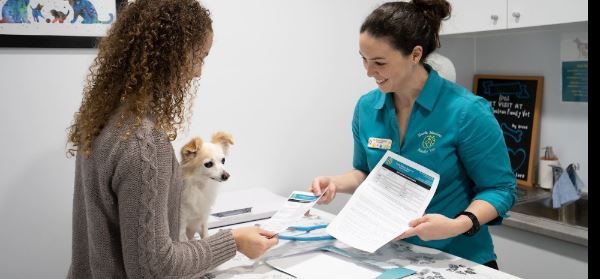Client Resources
Pre-anaesthetic and Pre-operative information

- Please bathe your dog the day before the procedure to remove heavy dirt and oils from the skin and coat.
- Please do not give your pet any food after midnight the day before the procedure or the morning of the procedure. Fasting is recommended to reduce the risk of vomiting and complications during the anaesthetic or initial recovery.
- Dinner the night before can be given as normal. Water may be provided at all times and does not need to be withheld.
- Please take your dog for a toilet walk before you arrive to the clinic.
Your pet will be admitted to our hospital between 8am and 9am in the morning. The admission process may be completed by a nurse or by a vet. Your pet’s vital signs will be checked, and you will be asked a few questions prior to the admission being completed. This is to ensure that your pet is fit and well enough for an anaesthetic, and the procedure to be performed with minimal risks.
After admission, your pet will have blood drawn for pre-anaesthetic testing (if you have elected this option) and have an intravenous catheter placed in preparation for the procedure.
A pre-medication will be administered to provide light sedation and pre-emptive pain relief. This pre-medication helps to improve the smoothness of the anaesthetic induction and recovery.
An anaesthetic induction agent is given intravenously, and will cause your pet to fall asleep in a controlled manner. An endotracheal tube is passed into the airway to ensure that oxygen can move freely with each breath. Anaesthetic gas is combined with oxygen and is given via the endotracheal tube. As your pet breathes, the anaesthetic gas ensures that your pet stays comfortably asleep and pain-free.

Our vets and nurses are exceptionally trained in anaesthetic monitoring and management. Your pet’s vital signs will be constantly monitored for the duration of the anaesthetic, as well as other parameters such as blood pressure, blood oxygenation levels, cardiac signals (ECG), and pain sensation. Adjustments to the anaesthetic and medications may be given to ensure that these parameters remain normal.
Once the procedure is complete, the anaesthetic gas is turned off, and your pet will start to slowly awaken. Our staff continue to monitor each patient closely during the initial recovery period, and will remove the endotracheal tube once your pet is breathing steadily and is able to swallow voluntarily. Your pet will then be settled comfortably into bed with warm blankets, and will be allowed to rest until completely awake. The initial recovery period can be between 10 minutes and 30 minutes, but complete recovery can take several hours.
- Your pet will need to be rested for a minimum of 24 hours following the anaesthetic. If a surgical procedure has been performed then this period may be longer. Please take note of the post-surgical recommendations made for your pet’s procedure.
- We recommend pet crates to help you keep your pet rested safely at home.
- An Elizabethan Collar (e-collar, or cone) is recommended for any patient that has sutures, wounds or bandages. This is to prevent them from licking and chewing at vulnerable areas. If you do not already have an e-collar at home, please let us know when your pet is admitted and we will ensure you have one when you go home.
- Other recommendations will be made on a case-by-case basis, and you will receive further information when your pet is discharged.

Every patient is assessed as an individual, and an individual anaesthetic and treatment plan is made. Many of us are aware that anaesthesia is a “risky” procedure, but may not understand what that means.
The common complications due to anaesthesia are unexpected reactions to medications, changes in blood flow resulting in organ compromise, vomiting, changes in breathing patterns and oxygenation, and excessive disorientation. In rare circumstances, unpredictable reactions can occur that can be difficult to manage. In some rarer cases, these reactions can be severe enough to cause sudden death.
Our intention is never to cause fear about the risks of anaesthesia. Adverse reactions and complications do not occur very often, and occur even less often with appropriate pre-anaesthetic assessment. Performing a thorough physical exam, blood and urine tests, x-rays, and other diagnostic tools, can help us identify potential problems before they arise, and work to create a plan that avoid the problem, or be adequately equipped to manage them should they occur. Certain decisions can be made about which medications are used in order to minimise the risk of complications.
A surgical plan is made for each patient based on a number of assessments. Some procedures have an expected outcome, and others require reassessment after the anaesthetic has begun. Even with a solidly formed surgical plan, some changes may need to be made during the procedure based on findings at the time.
Modern medicine and sterilisation techniques help us minimise the risk of post-operative complications such as infections, pain, and swelling. Recommendations for home care and follow-up visits help reduce the risk of suture failure and infections. However, despite all recommendations and treatments, unexpected complications can occur that may require further surgical treatment or other procedures. Our goal is to provide you with the most information possible, and approach each case step by step.


